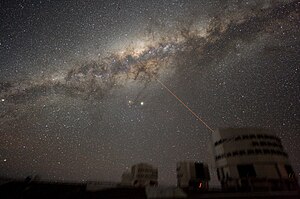Milky Way galaxy

The Milky Way's Galactic Center in the
night sky above Paranal Observatory (the laser creates a guide-star for the telescope). |
|
| Observation data | |
|---|---|
| Type | Sb, Sbc, or SB(rs)bc (barred spiral galaxy) |
| Diameter | 100–180 kly (31–55 kpc) |
| Thickness of thin stellar disk | ≈2 kly (0.6 kpc) |
| Number of stars | 100–400 billion (2.5×1011 ±1.5×1011) |
| Oldest known star | ≥13.7 Gyr |
| Mass | 0.8–1.5×1012 M☉ |
| Angular momentum | ≈1×1067 J s |
| Sun's distance to Galactic Center | 26.4 ± 1.0 kly (8.09 ± 0.31 kpc) |
| Sun's Galactic rotation period | 240 Myr |
| Spiral pattern rotation period | 220–360 Myr |
| Bar pattern rotation period | 100–120 Myr |
| Speed relative to CMB rest frame | 552 ± 6 km/s |
| Escape velocity at Sun's position | 550 km/s |
| Dark matter density at Sun's position | 0.0088+0.0024 -0.0018 M☉pc-3 or 0.35+0.08 -0.07 GeV cm-3 |
| See also: Galaxy, List of galaxies | |
The Milky Way is the galaxy that contains our Solar System. The descriptive "milky" is derived from the appearance from Earth of the galaxy – a band of light seen in the night sky formed from stars that cannot be individually distinguished by the naked eye. The term "Milky Way" is a translation of the Latin via lactea, from the Greek γαλαξίας κύκλος (galaxías kýklos, "milky circle"). From Earth, the Milky Way appears as a band because its disk-shaped structure is viewed from within. Galileo Galilei first resolved the band of light into individual stars with his telescope in 1610. Until the early 1920s, most astronomers thought that the Milky Way contained all the stars in the Universe. Following the 1920 Great Debate between the astronomers Harlow Shapley and Heber Curtis, observations by Edwin Hubble showed that the Milky Way is just one of many galaxies.
The Milky Way is a barred spiral galaxy with a diameter between 100,000 light-years and 180,000 light-years. The Milky Way is estimated to contain 100–400 billion stars. There are likely at least 100 billion planets in the Milky Way. The Solar System is located within the disk, about 26,000 light-years from the Galactic Center, on the inner edge of one of the spiral-shaped concentrations of gas and dust called the Orion Arm. The stars in the inner ≈10,000 light-years form a bulge and one or more bars that radiate from the bulge. The very center is marked by an intense radio source, named Sagittarius A*, which is likely to be a supermassive black hole.
...
Wikipedia
